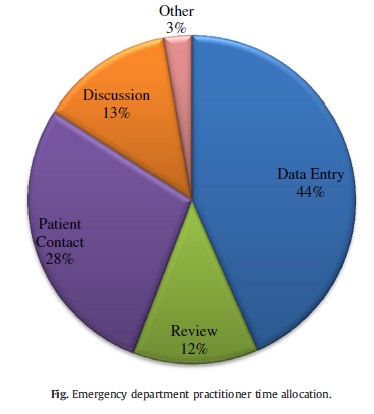I started voicing my concerns about trying to use an electronic trauma flow sheet (eTFS) way back in 2008. There are very few reports in the literature that specifically detail using the EHR as a trauma flow sheet. The first (see reference 1 below) described an early experience with the conversion process. It outlines lessons learned during one center’s experience, and I’ve not seen any published followup from that center.
Now, on to a report of a “positive” experience. A Level I pediatric trauma center made the same change to the eTFS. They designed a custom menu-driven electronic documentation system, once again using Epic. Specific nurses were trained to act as the
electronic scribe, and had to be present at every trauma resuscitation. The goal of the study was to compare completion rates between paper and electronic documentation. One year of experience with each was collected.
Here are the factoids:
- There were about 200 trauma activations each year that were admitted, and only 50 or so were highest level activations (in a year!)
- 11 data elements were compared, including treatments prior to arrival, vitals, fluids, primary survey, level and time of activation, patient and surgeon arrival, and disposition
- The eTFS was better at capturing time of activation, primary survey components, attending arrival time, and fluid administration
Yes. That’s it. They looked at 11 data points. It says nothing about the wealth of other information that has to be recorded and needs to be abstracted or analyzed. And nothing about the reports generated and their utility. Or how much additional time must be spent by the trauma PI program to figure out what really happened. Or how good their paper documentation was in the first place (not so good, apparently). Or the bias of knowing that your documentation under Epic is being scrutinized for the study.
And to get to that level, this hospital had to maintain a complement of highly trained nurses who were facile with their customized Epic trauma narrator. And they had to maintain their skills despite seeing only one highest level trauma activation patient per week, or one activation at any level only every other day.
I’ve had a number of discussions with the trauma program manager from this hospital, and I am convinced that they have managed to make it work well at their center. However, I’m not certain that their system can be generalized to hospitals with higher volumes and and degree of staffing restraints.
In my final post of this series, I’ll tell you what I really think about using the electronic trauma flow sheet in your trauma resuscitations, and why.
References:
- Using the electronic medical record for trauma resuscitations: is it possible? J Emerg Nursing 36(4):381-384, 2010.
- A comparison of paper documentation to electronic documentation for trauma resuscitations at a Level I pediatric trauma center. J Emerg Nursing 41(1):52-56, 2015.

